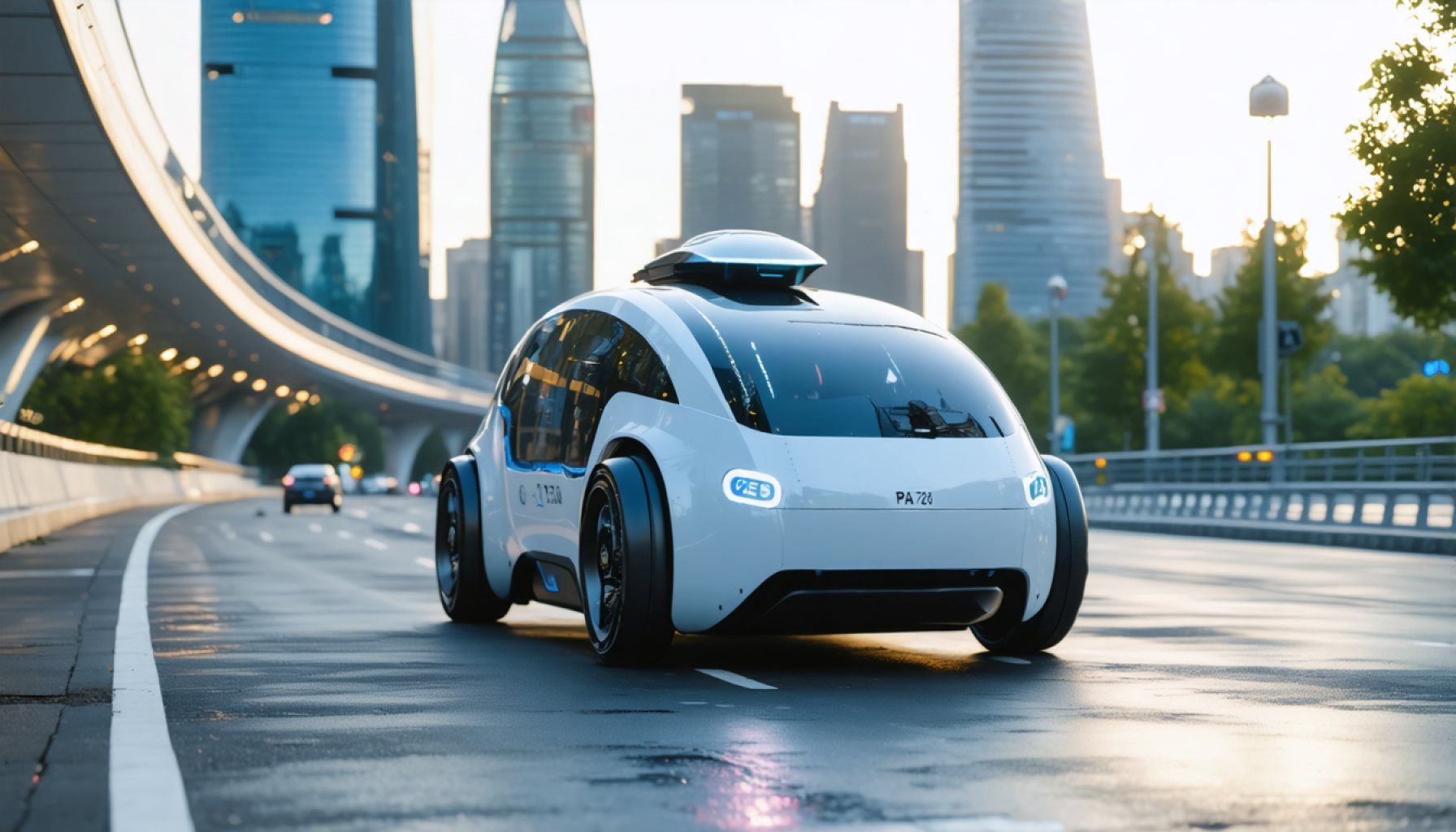- Robotaxis, or autonomous driverless vehicles, are transforming urban transportation by providing efficient and eco-friendly solutions to congestion and pollution.
- These vehicles use AI, machine learning, and advanced sensor systems like LiDAR and radar for precise navigation and safety.
- Prominent companies like Waymo and Baidu are leading the development, ensuring high standards of safety and reliability.
- Robotaxis primarily use electric power, contributing to reduced urban emissions and improved air quality.
- Personalization and the integration of virtual assistants and data analytics enhance the user experience, reflecting the demand for tailored, on-demand services.
- Challenges include regulatory and operational issues, necessitating collaboration with governments and tech industries for smooth implementation.
- Innovation is critical, with AI and IoT technologies improving vehicle-to-infrastructure communication and urban mobility networks.
- Adaptation, foresight, and strategic planning are essential for stakeholders to thrive in the evolving Robotaxi market.
A new dawn in urban transportation is breaking over bustling cityscapes worldwide. The advent of Robotaxis—driverless, autonomous vehicles poised to reshape how we move through the world—is no longer a distant sci-fi dream but an imminent reality in the rapidly evolving transportation landscape.
Imagine a world where mobility is seamless, efficient, and eco-friendly. In the face of rising urban populations and increasing congestion, Robotaxis offer a compelling solution. These vehicles navigate the urban jungle with precision, guided by a web of cutting-edge technologies including artificial intelligence (AI), machine learning, and advanced sensor systems like LiDAR and radar.
Technological strides have enabled these autonomous vehicles to detect obstacles, make split-second decisions, and transport passengers safely without human intervention. Companies at the forefront of this innovation, such as Waymo in the United States and Baidu in China, are setting new benchmarks for safety and reliability, accelerating the deployment of Robotaxi services across major cities.
But what truly sets this robotic revolution apart is its sustainability potential. With most Robotaxis anchored to electric power, they are spearheading the charge toward reduced urban emissions and better air quality. The global push for greener alternatives aligns perfectly with the capabilities of these vehicles, making them an essential component in modern efforts to transform urban environments.
As we glance skyward to see Robotaxis cruising down city streets, personalization remains key to their widespread acceptance. Consumers, now accustomed to the convenience of on-demand services, are eager for transportation options that tailor rides to their preferences. Sophisticated technology ensures these vehicles are not merely transportation but personalized experiences equipped with virtual assistants and real-time data analytics.
Yet, as with any transformative technology, challenges loom on the horizon. The path ahead is fraught with regulatory hurdles and operational challenges, potentially slowing the momentum. Close collaboration with governmental bodies and strategic partnerships with technology and automotive industries are critical to navigate this complex terrain.
Despite these obstacles, the opportunities are immense. The Robotaxi industry stands at the cusp of a major shift, with untapped regions and evolving consumer demands promising robust growth. Cities plagued by traffic congestion and pollution are ripe for transformation, and those poised to seize the moment can redefine the urban experience.
Innovation continues to drive the Robotaxi market, where the integration of AI and IoT technologies is paramount. By improving communication networks between vehicles and infrastructure, these advancements promise not only safer rides but a more integrated and responsive urban mobility network.
In this brave new world of transportation, adaptation and foresight will chart the way forward. Stakeholders who remain agile and informed, ready to innovate at the intersection of technology and transportation, will undoubtedly thrive in this dynamic environment. The Robotaxi revolution is not just about getting from one place to another—it’s about creating a better future for all who inhabit our bustling metropolises.
The Robotaxi Revolution: How Driverless Transport is Reshaping Cities
Introduction
The emergence of Robotaxis is set to redefine urban mobility, offering a vision of a future where transportation is seamless, efficient, and environmentally friendly. As major companies like Waymo and Baidu lead the charge, the reality of autonomous, driverless vehicles navigating city streets is fast approaching. Let’s explore the additional layers of this transformative technology, its implications, and how you can navigate this new transportation landscape.
How Robotaxis Work: Technology and Innovation
Robotaxis leverage an array of cutting-edge technologies:
– Artificial Intelligence (AI) and Machine Learning: These systems enable vehicles to learn from vast datasets, improving decision-making over time.
– Sensor Systems: Technologies like LiDAR, radar, and cameras provide a comprehensive view of the vehicle’s surroundings, ensuring accurate obstacle detection and navigation.
– Connectivity and IoT: By connecting with city infrastructure, Robotaxis can receive real-time traffic updates, improving route efficiency and safety.
Sustainable Urban Transit
Robotaxis largely utilize electric power, supporting efforts to reduce carbon emissions and improve air quality in congested areas. As urban populations grow, cities are under pressure to adopt greener transportation solutions. Robotaxis are pivotal in these efforts, offering cleaner transit options.
Personalization and User Experience
Consumers are increasingly interested in personalized transport experiences. Robotaxis may offer:
– Virtual Assistants: Enhancing comfort and convenience by catering to individual preferences.
– Real-Time Analytics: Providing data on routes and expected travel times, allowing for optimized journeys.
Challenges and Regulatory Considerations
While promising, the path to widespread Robotaxi adoption is fraught with challenges:
– Regulatory Hurdles: Navigating the legal landscape requires close collaboration with government entities and clear standards for safety and operation.
– Operational Challenges: Developing reliable infrastructure and ensuring cybersecurity are paramount to gaining public trust.
Market Forecasts and Industry Trends
The Robotaxi industry is anticipated to grow significantly. McKinsey & Company projects a global autonomous-vehicle market worth over $500 billion by 2035. This growth is driven by:
– Urbanization: Increasing demand for efficient mobility solutions in densely populated areas.
– Technological Advancements: Continuous improvements in AI and sensor technologies.
Reviews and Comparisons
Comparing leading Robotaxi services reveals diverse approaches:
– Waymo’s Comprehensive Testing: Waymo has extensive road testing, particularly in diverse weather conditions, cementing its reputation for safety and reliability.
– Baidu’s Integration with Smart City Infrastructure: Baidu is prominent in integrating with China’s smart city initiatives, offering seamless connectivity between vehicles and urban infrastructure.
Pros and Cons Overview
Pros:
– Reduced traffic congestion.
– Lower emissions.
– Enhanced safety with reduced human error.
Cons:
– High initial setup and maintenance costs.
– Potential job displacement in traditional taxi services.
– Privacy concerns regarding data collection.
Actionable Recommendations
To prepare for the arrival of Robotaxis:
1. Stay Informed: Regularly update yourself on local regulations and pilot programs.
2. Adopt Early: Engage with pilot programs to experience the benefits firsthand.
3. Advocate for Infrastructure: Encourage investment in urban infrastructure to support autonomous vehicles.
Conclusion
Robotaxis present an exciting, sustainable future for urban transportation. By focusing on innovation, regulatory cooperation, and consumer demands for personalization, this technology has the potential to transform city mobility. Staying informed and engaged with these advancements will help you make the most of the Robotaxi revolution.
For more insights into autonomous vehicles and urban mobility, visit [Waymo](https://waymo.com) and [Baidu](https://baidu.com).











